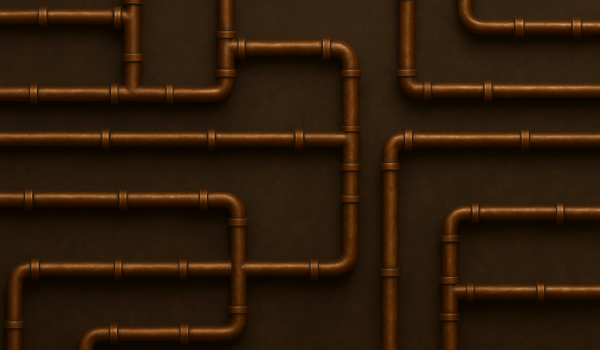In the UK, 85% of residential buildings, equating to 23 million in total, are connected to the gas grid and have gas transported through the building via a tubing network. With so many households having these networks, using appropriate, safe and sustainable materials is of utmost importance.
There are several different options when it comes to gas pipes but unfortunately, we are seeing a rise in unsustainable options such as corrugated stainless-steel tubing (CSST), which is made up of stainless-steel tube coated with either one or two layers of PVC plastic. Due to the inclusion of two different materials, this makes the recycling of this type of product very difficult.
Another option for gas piping is copper, which has been the professional plumber’s choice for decades. So, what is it about copper that makes it the superior option?
It’s all in the composite
Originally developed in Japan, CSST was designed to be flexible to be able to withstand earthquakes. To achieve flexibility, CSST is very thin, therefore making it more susceptible to damage.
Due to its lean composition, CSST pipes have been known to get accidentally punctured by nails being driven into walls by homeowners which, when carrying gas, is less than ideal. Additionally, the welded seams in the stainless-steel tube create weak spots in the pipe, which is worsened by the complicated ways in which the fittings need to be adhered to the pipe, putting further pressure on the seams and increasing the chance of a leak.
If there’s a leak in CSST piping, it could be immediately evident or it could remain undetected for months. As if assumed to fail, CSST is made of multiple layers, with the second designed to act as a backup leak zone for when the first layer leaks. But what happens when the second layer inevitably leaks?
On the other hand, copper pipes are a reliable solution that have remained the pro plumber’s choice for generations. Copper has been used in piping for 4,000 years and has truly stood the test of time. Strong, sturdy, and seamless, copper pipes reduce the chance of leaks, and its reliability is evidenced in its uses. With Swedish scientists and technologists trusting the natural material to encapsulate radioactive waste, it is more than qualified to transport gas around residential properties.
Learn more about copper’s impressive properties below.
A question of sustainability
Generally, at the end of their life, CSST pipes are landfilled or burned as they hold no recyclable value. This is largely due to their complex makeup as it is very hard to separate the metal and plastic layers. The process to reclaim the metal within would be incredibly labour intensive and costly, outweighing any value that could be retained. What’s more, plastic can take hundreds of years to breakdown, meaning that several generations of a family can live in the time it takes for one landfilled pipe to disintegrate.
While it is possible to recycle plastic and it should be done wherever feasible, Zero Waste Europe reports that PVC in particular can be difficult to recycle. This is partly because of additives and the fact that recycled PVC often contains hazardous additives and toxicants, making it very difficult to repurpose and recycle.
According to Greenpeace, since plastic cannot decompose, every piece of the unnatural material ever produced still exists, plaguing the planet with dangerous microplastics. Why do we continue to worsen this problem?
By large contrast, copper is 100% infinitely recyclable and, to date, at least 65% of all copper mined remains in circulation. As a result, approximately half of Europe’s copper consists of recycled materials. What’s more, copper pipes retain all their qualities and value, no matter how many times they have been recycled.
With the construction industry generating one quarter (23%) of the UK’s plastic consumption, reducing and eliminating the use of plastics in piping would be greatly beneficial, especially considering a sustainable option is available, and has been for thousands of years.
Learn more about the sustainability credentials of copper below.
The safest option is the natural choice
One of the most prominent risks posed by CSST is its fire risk. An official building code report published by the International Code Council states that plastic materials can melt and leave a “dangerous void” when subjected to heat. Many plastics are intumescent materials, which means they grow in size in the event of fire, which creates extreme fire hazards.
Voids in tower blocks allow amenities to be delivered to flats in pipes that run all the way up the side of the building. Due to the plastic’s high level of combustibility, CSST is not the safest material to fulfil this purpose. Moreover, should the fire reach the tubing, the toxic fumes caused by the burning plastic can be damaging for people and planet alike.
A safer choice, copper is an inflammable material and has a melting point of 1,085°C. In the unfortunate case of a fire, copper piping would not lead to any further hazards. It begs the question of why a flammable material such as plastic would be chosen to transport a highly flammable gas around a building, when a far safer option like copper is available.
For centuries, copper has prevailed as one of the safest, most sustainable, and most reliable materials in piping. The construction industry must leave CSST in the past and adopt one of the world’s oldest solutions now, for the future of the planet and its population. After all, the S’s in CSST do not stand for safe nor sustainable.
Learn more about the advantages of copper pipes over plastic pipes below.

